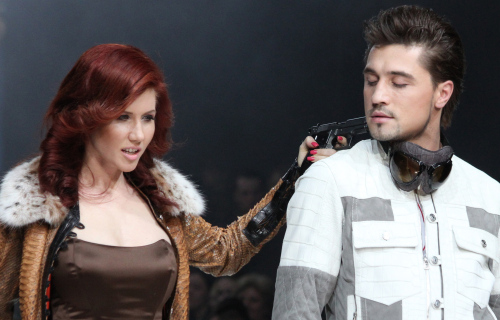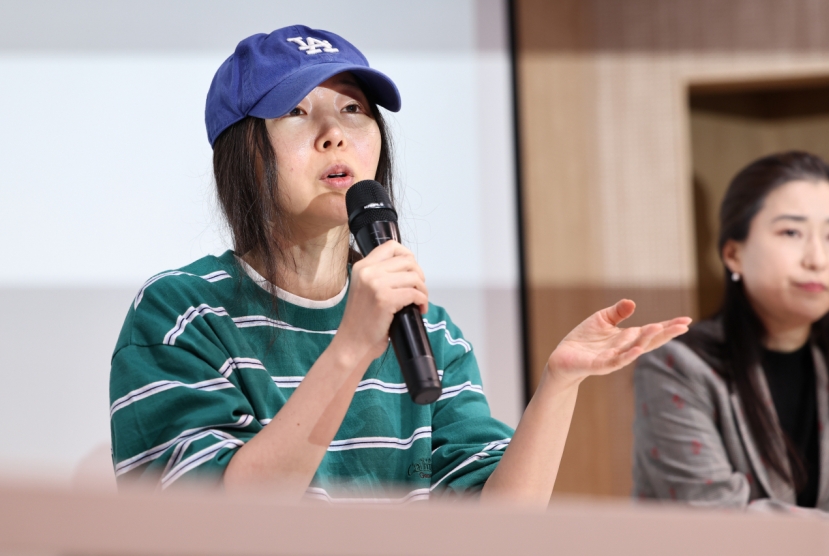WASHINGTON (AP) -- Unaware the FBI has her under surveillance, Russian spy Anna Chapman buys leggings and tries on hats at a Macy's department store. A few months later, cameras watch her in a New York coffee shop where she meets with someone she thinks is her Russian handler. It is really an undercover FBI agent.

Tapes, documents and photos released Monday describe and sometimes show how Chapman, now a celebrity back in Russia, and other members of a ring of sleeper spies passed instructions, information and cash. The ring was shut down in June 2010 after a decade-long counterintelligence probe that led to the biggest spy swap since the Cold War.
The FBI released the material to The Associated Press in response to a Freedom of Information Act request. The investigation was code-named ``Ghost Stories,'' the release of documents on Halloween a coincidence.
While the deep-cover agents did not steal any secrets, an FBI counterintelligence official told the AP they were making progress.
They ``were getting very close to penetrating U.S. policymaking circles'' through a friend of a U.S. Cabinet official, said C. Frank Figliuzzi, FBI assistant director for counterintelligence.
He did not name names, but Russian spy Cynthia Murphy of Montclair, New Jersey, provided financial planning for venture capitalist Alan Patricof, a political fundraiser with close ties to Bill and Hillary Rodham Clinton.
The linchpin in cracking the case, apparently, was Col. Alexander Poteyev, a highly placed U.S. mole in Russian foreign intelligence, who betrayed the spy ring even as he ran it.
He abruptly fled Moscow just days before the FBI rolled up the operation. Poteyev's role emerged when a Russian military court convicted him in absentia for high treason and desertion.
The materials released Monday show Chapman and the other members of Moscow's 11-member ring of sleeper spies _ deep-cover agents assigned to blend into American society _ shopping in New York City, sightseeing, hanging around coffee shops or apparently just out for a stroll. While she shops at one department store, a Russian diplomat waits outside.
The FBI says seemingly mundane pursuits often served as cover for the exchange of encrypted messages or the transfer of cash, all with the long-range goal of penetrating the highest levels of U.S. policymaking.
What appears to be a family photo of one spy, Donald Heathfield of Cambridge, Massachusetts, shows him graduating from Harvard's John F. Kennedy School of Government in 2000. The school revoked the degree a month after the FBI rolled up the spy ring.
Other spies are seen in video and photos meeting at various locations in New York.
Called ``illegals'' because they took civilian jobs instead of operating with diplomatic immunity inside Russian embassies and military missions, the spies settled into quiet lives in middle-class neighborhoods and set about trying to network their way into the worlds of finance, technology and government.
The operation's codename, Ghost Stories, stems from a number of the spies using a technique known among counter-intelligence investigators as ``dead doubles'' _ taking the identities of people who have died. Tracey Lee Ann Foley, Michael Zottoli, Donald Heathfield and Patricia Mills all used the technique, Figliuzzi said.
The U.S. traded the 10 ``Ghost Stories'' spies arrested by federal agents for four Russians imprisoned for spying for the West at a remote corner of a Vienna airport on July 9 in a scene reminiscent of the carefully choreographed exchange of spies at Berlin's Glienicke Bridge during the Cold War.
While freed Soviet spies typically have kept a low profile after their return to Moscow, Chapman became a model, corporate spokeswoman and television personality. Heathfield, whose real name is Andrey Bezrukov, lists himself as an adviser to the president of a major Russian oil company on his LinkedIn account.
Russian President Dmitry Medvedev awarded the 10 freed spies Russia's highest honors at a Kremlin ceremony.
The case was brought to a swift conclusion before it could complicate U.S. President Obama's campaign to ``reset'' American relations with the Kremlin, strained by years of tensions over U.S. foreign policy and the 2008 Russian-Georgian war. All 10 of the captured spies were charged with failing to register as foreign agents.
An 11th suspect, Christopher Metsos, who claimed to be a Canadian citizen and was accused of delivering money and equipment to the sleeper agents, vanished after a court in Cyprus freed him on bail. The FBI released surveillance photos of Metsos on Monday.
Figliuzzi said Metsos traveled into the U.S. solely for the purpose of providing the other illegals with money. Security measures after the Sept. 11 terrorist attacks meant he could no longer risk carrying large amounts of cash, prompting the Russians to send officials already in the U.S. to meet with the illegals and pay them.
That could have made them more vulnerable to discovery.
He said Chapman and another illegal, Mikhail Semenko, who worked in a D.C.-area travel agency, represented a ``new breed'' of illegals operating in the U.S. under their own names.
Chapman and Semenko ``were very tech savvy, very intellectual and bright,'' he said, adding that Semenko is fluent in five languages including Chinese.
Both of the new-breed operatives used state-of-the-art wireless computer communications, but the others fell back on techniques that have been used for centuries. With the two different approaches, ``the Russians were experimenting,'' said Figliuzzi.
The FBI official said that Chapman's ring was the largest network of illegals ever seen in the U.S. By working on the case for so long, he said, the FBI penetrated the ring's communications network to the point where FBI officials were playing the part of Russian handlers. ``So in a sense we began to own their communications and we became the Russians,'' Figliuzzi said.
But former Soviet intelligence officials now living in the West scratched their heads over what Russia hoped to gain from its ring.
``In my view this whole operation was a waste of human resources, money and just put Russia in a ridiculous situation,'' said Oleg Kalugin, a former KGB major general who spied against the U.S. during the Soviet era, in an interview earlier this year. He now lives near Washington.
Alexander Vassiliev, a former KGB officer and journalist who has written extensively about Soviet spying in America, said the illegals were supposed to act as talent spotters and scouts, identifying Americans in positions of power who might be recruited to spill secrets for financial reasons or through blackmail.
Spies with the protection of diplomatic credentials would handle the more delicate task of recruiting and handling the agents.
Moscow's ultimate aim, Vassiliev said, was probably to cultivate a source who could provide day-by-day intelligence on what the president's inner circle was thinking and planning in response to the latest international crisis. But he said there was no evidence the Kremlin made any progress toward that goal.
``How are you going to recruit someone like that, on what basis? That's quite a successful person. Why should he spy for the Russians? I can't see any reason, said Vassiliev, who now lives in London.
<한글기사>
러시아 스파이 비밀 영상 공개
지난해 미국에서 간첩혐의로 체포된 안나 채프먼 등 러시아 스파이의 활동을 촬영한 영상이 31일(현지시간) 공개됐다.
미 연방수사국(FBI)은 당시 스파이 10여명을 체포하기 전 거리와 백화점, 커피 숍 등에서 이들을 감시 카메라로 지켜봤다.
영상에서 채프먼은 메이시스 백화점에서 레깅스를 사고 모자를 써 보는 모습이 포착됐으며 이곳에서 쇼핑하는 동안 바깥에서는 러시아 외교관이 그녀를 기다리는 모습이 나온다.
채프먼은 몇 달 후인 2010년 6월 러시아 조직원으로 위장한 FBI 요원을 뉴욕 커 피숍에서 만났다.
FBI는 AP 통신이 정보자유법에 따라 자료를 요청하자 '유령 이야기'라는 작전명 으로 이들의 활동을 담은 영상과 테이프, 문서, 사진 등 각종 자료를 이날 공개했다 .
작전명은 간첩단이 대부분 이미 사망한 사람의 신분을 이용한다는 점에서 명명 됐다.
공교롭게도 이날은 죽은 사람의 영혼이 집으로 돌아온다고 믿는 데서 유래한 서 양 축제 '핼러윈' 데이다.
FBI는 10년간 이들을 감시한 결과 산책을 하려고 바깥출입을 하거나 하버드대 케네디 스쿨 졸업식에 참가하는 등 평범한 생활로 위장하면서 암호화된 메시지와 활 동에 필요한 자금 등을 전달받았다고 분석했다.
중산층 이웃의 삶으로 들어가 금융과 테크놀러지, 정부 네트워크에 접촉을 시도 하려 했다는 것이다.
FBI는 이들이 미국의 기밀정보를 빼내지는 못했지만 정계와 연관된 계통으로 거 의 침투할 뻔했다고 설명했다.
이들이 접촉을 시도한 각료의 이름은 밝혀지지 않았지만 러시아 스파이 신시아 머피는 빌 클린턴 전 대통령과 힐러리 클린턴 국무장관 부부와 친한 관계로 정치자 금을 조달한 벤처 자본가 알랜 패트리코프에게 재무계획을 제공한 바 있다.
러시아 간첩단 중 채프먼과 미하일 세멘코는 특히 첨단 무선 컴퓨터 통신에 능 하고 사망한 사람의 신분을 이용하는 다른 요원들과는 달리 자신의 이름을 활동에 그대로 사용했다는 점에서 주목을 받았다.



![[Herald Interview] 'Amid aging population, Korea to invite more young professionals from overseas'](http://res.heraldm.com/phpwas/restmb_idxmake.php?idx=644&simg=/content/image/2024/04/24/20240424050844_0.jpg&u=20240424200058)















